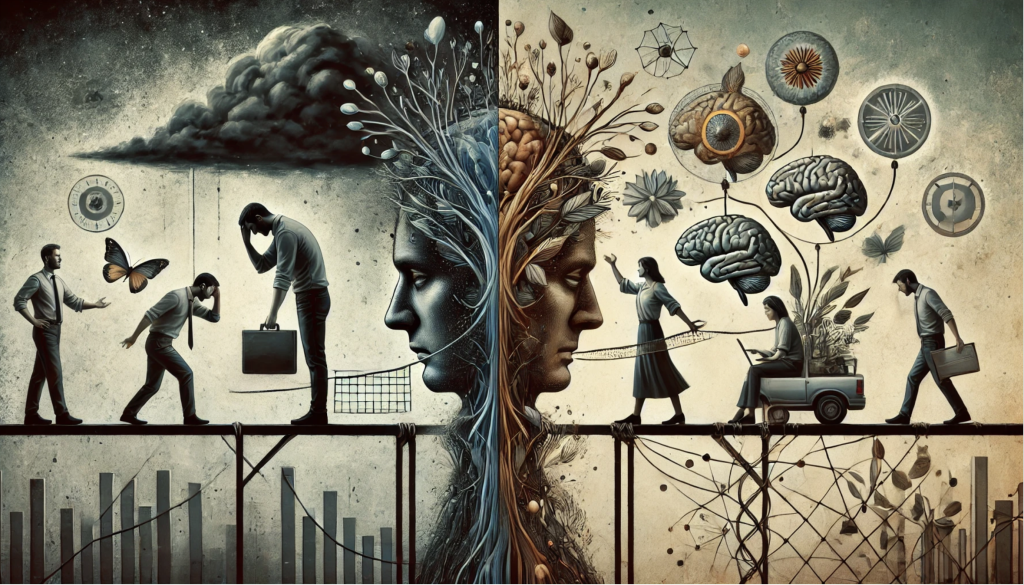Mood disorders in males vs females present unique challenges due to a variety of biological, psychological, and social factors. While both men and women experience conditions like depression and bipolar disorder, the symptoms, prevalence, and treatments can vary widely. It is important to note that this blog focuses strictly on biological sex differences, as supported by scientific research, to help readers better understand how mood disorders affect males and females differently. These insights aim to offer guidance toward more effective mental health care, based on facts and biological science.
What Are Mood Disorders?
To fully grasp the differences between mood disorders in males vs females, it is essential to understand what mood disorders are. Mood disorders are mental health conditions that primarily affect a person’s emotional state. These disorders can involve prolonged periods of excessive sadness (depression) or fluctuating mood swings (bipolar disorder). Common symptoms include persistent sadness, irritability, fatigue, changes in sleep patterns, and difficulty concentrating.
Depression, for example, is characterized by a loss of interest in activities, feelings of hopelessness, and sometimes suicidal thoughts. Bipolar disorder, on the other hand, involves periods of mania (extreme high energy and impulsiveness) alternating with depression. According to the National Institute of Mental Health (NIMH), mood disorders are some of the most common mental health conditions, affecting millions of individuals globally each year. These findings are based on biological and clinical studies to understand the impact on both men and women.
Prevalence of Mood Disorders in Men vs Women
The prevalence of mood disorders in men vs women shows distinct differences in how often these conditions are diagnosed across biological sexes. According to global data, women are almost twice as likely as men to be diagnosed with major depressive disorder (source). Hormonal fluctuations, especially related to menstruation, pregnancy, and menopause, are scientifically known to contribute to this higher risk.
Men, however, are more likely to underreport depressive symptoms and may express their emotional struggles through anger, irritability, or substance abuse. This underreporting is often due to social factors and a reluctance to acknowledge mental health issues. Research from the American Psychological Association (APA) suggests that societal norms can influence the expression of mood disorders in men (source). While the prevalence of bipolar disorder is roughly equal between men and women, women may experience more rapid cycling and mixed states (source). These observations are based on biological and clinical data that help highlight the need for gender-specific mental health interventions.
How Hormones Affect Mood Disorders in Men and Women
Hormones play a significant role in the development and severity of mood disorders in both men and women. In women, estrogen and progesterone fluctuations are linked to mood changes, particularly during life stages like puberty, pregnancy, postpartum, and menopause. These hormonal shifts are backed by scientific studies that show a direct correlation between estrogen levels and mood disturbances such as depression and anxiety (source).
In men, testosterone plays a role in mood regulation. Low testosterone levels, particularly in aging men, have been linked to mood swings, irritability, and depression (source). These hormonal impacts are rooted in biological research. The key takeaway is that hormones greatly affect mood disorders in men and women, influencing the way these disorders manifest and progress.
Gender Differences in Symptoms of Mood Disorders
One of the most notable aspects of mood disorders is the gender differences in symptoms experienced by men and women. Research shows that men are more likely to display symptoms of anger, and aggression, or engage in risky behaviors when suffering from depression or bipolar disorder. In contrast, women often report more feelings of sadness, fatigue, and withdrawal from social activities.
These differences are supported by clinical observations and psychological studies. Men tend to cope with emotional distress differently than women, which can lead to delayed diagnosis or inappropriate treatments. According to research published by the Mayo Clinic, men may be more prone to coping through unhealthy behaviors, such as alcohol or drug use, further masking their symptoms (source). The gender differences in symptoms of mood disorders are rooted in biological and psychological research, highlighting the need for accurate identification and appropriate treatment approaches based on these facts.
Impact of Social and Cultural Factors on Mood Disorders
 Mood disorders are primarily rooted in biological processes. However, social and cultural factors also shape how they manifest and are treated. These influences differ between men and women, impacting their experiences with mood disorders.
Mood disorders are primarily rooted in biological processes. However, social and cultural factors also shape how they manifest and are treated. These influences differ between men and women, impacting their experiences with mood disorders.
For men, societal pressures often discourage expressing emotions or seeking help. Many men feel they must appear strong and unemotional, which can prevent them from addressing mental health struggles. According to studies by the World Health Organization (WHO), this reluctance can result in untreated depression. Over time, untreated depression increases the risk of suicide, substance abuse, and other harmful outcomes.(source)
Women, by contrast, tend to be more likely to seek help for mood disorders. However, they face unique challenges in their treatment journeys. Women often juggle caregiving responsibilities with their own mental health needs. These dual roles can create added stress, which complicates their ability to focus on their own well-being. Additionally, the pressure to maintain emotional balance for others may delay or limit the effectiveness of treatment.
Although these social and cultural factors influence how mood disorders are experienced and treated, the core causes remain biological and psychological. Research consistently shows that both men and women are affected by genetic and neurological factors. However, social dynamics often shape how these underlying issues are expressed.
Understanding how social and biological factors intersect is essential for addressing mood disorders more effectively. This intersection helps healthcare professionals provide more tailored and comprehensive care.
Treatment Options for Mood Disorders in Males vs Females
Treatment options for mood disorders often differ based on biological factors, especially hormonal influences. Women may need treatments that consider hormonal changes during specific life stages, such as pregnancy or menopause, to manage mood fluctuations better. For example, hormone-based therapies may be considered alongside traditional treatments like cognitive-behavioral therapy (CBT) or antidepressant medications (source).
In men, treatment often requires addressing underlying issues like substance use or anger management, alongside traditional depression or anxiety treatments. These treatment approaches are based on biological evidence and tailored to the unique hormonal and psychological needs of each sex. The goal is always to address the underlying causes of the mood disorder based on the most accurate scientific data available.
Breaking the Stigma: Encouraging Mental Health Awareness for All
This blog focuses on biological differences, but it’s also important to address mental health stigma, especially for men. Societal norms often downplay men’s mental health struggles. However, untreated mood disorders can lead to serious consequences. Raising awareness is crucial to overcoming this stigma. Encouraging open conversations and providing access to mental health care is critical in addressing these conditions early on.
For women, promoting awareness around specific conditions like postpartum depression is essential. Breaking the stigma requires relying on science and facts to address mood disorders in both sexes. Awareness and public health initiatives must be based on biological and psychological research to reduce stigma and improve mental health outcomes effectively.
Conclusion: Understanding Mood Disorders in Males vs Females
Understanding mood disorders in males vs females is essential for addressing the mental health needs of both men and women. These differences are not based on societal beliefs or stereotypes but are rooted in biological research and scientific facts. The goal is to improve treatment options by focusing on the biological and psychological factors that drive mood disorders in both sexes. Recognizing the nuances of mood disorders based on scientific findings helps advance mental health treatment for all individuals.
Take the First Step: Get Evaluated at Ability Psychological Services
If you or a loved one is struggling with mood disorders, now is the time to take action and get evaluated at Ability Psychological Services. Professional evaluation is key to identifying whether symptoms like irritability, sadness, or fatigue are related to mood disorders such as depression or bipolar disorder.
At Ability Psychological Services, we offer comprehensive assessments tailored to both men and women. Our evaluations are based on scientific and biological principles, ensuring that you receive the most effective care for your condition. Early intervention is critical in managing mood disorders and improving your overall quality of life.
Don’t wait—take the first step toward mental wellness and get evaluated at Ability Psychological Services to start your journey to better mental health today.




